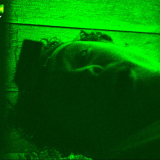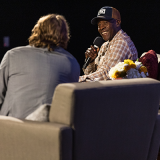Dinner with Rob Legato, VFX Supervisor
April 13, 2012
Wednesday evening, Rob Legato visited the Folino theater to discuss creating the effects for Hugo (one of my favorite 3D films ever!) in the stereoscopic medium with 3D-projected behind-the-scenes footage. Additionally, Rob was here for a delicious dinner in the Fashionable Women of Chapman Rotunda Board Room to meet interested students for a more intimate discussion. Digital Arts Club head Ari Felbowitz attended both, and shares his thoughts below on having the award-winning filmmaker with us. (And check out some of Ari’s work here!) -JP
Guest Blogger Ari Felbowitz (Digital Arts, ’12)
What impresses me most about Rob Legato is his literal, can-do attitude. In fact, he hates the word “no.”
When someone tells him that something can’t be done, he proves that it can be done. He made a comparison to the moon landing when he said something along the lines of “When they wanted to go to the moon they didn’t have the means to get there, but they knew they wanted to go, so they created the means to do it, it’s the same with visual effects and anything else.”
As can be seen on IMDB.com he is the VFX supervisor of titles such as Hugo, Aviator, What Lies Beneath, Titanic, and many other wonderful films such as one of my favorite Harry Potter movies. He also worked on Avatar, the film widely credited for spurring the 3D revolution.
Most of his lecture focused on the behind the scenes of Hugo. He also gave us his back story and great stories from behind the scenes of various projects he has worked on.
He claimed the most fun he has ever had on set was while working on a commercial directed by Martin Scorsese called “The Key to Reserva” because it was referencing Alfred Hitchcock movies in a comical fashion.
Rob started off in film and was going into producing. He was fascinated by VFX, but never thought he would get into that field professionally. His perspective changed one day, suddenly, on set: he was working on a car commercial, which required a shot of the actor jumping out of the sun roof of his car and landing in another car. People told him the shot could never be accomplished. He tried various angles and camera tricks, but none worked.
Discouraged, he consulted with other people working on set, and found a simple solution he could accomplish with VFX. Suddenly, people saw him as a person who could problem solve and think in ways others couldn’t on set. Whenever he felt he needed to do something that couldn’t be done, he would find a way to do it.
He said that when we enjoy something in art, no matter what the form is, we should keep it in the back of our minds, because something we like about it may work it’s way into our work.
Of course, once VFX went all-digital, he was already there working in the digital medium, making him in very high demand – he was perfectly positioned to leverage his creative past into a productive, future-looking career.
He also had some great stories from working on Hugo, like how he built a revolving slide, or how compositors dropped out of the opening shot of Hugo 3 days before the film was due. He also explained that most of the sets you see in Hugo are CG, and we were able to see the film stripped of all its VFX magic. It’s really impressive to behold how much of a film is created and animated in computers; take look for yourself:
All in all, I loved having the chance to hear from him in person, and to hear about his struggles on and off stage. I found his talks extremely motivational, and I hope to incorporate some of his teachings into my life. Not to mention the simple fact that such an impressive man came to our school to speak with us, I really couldn’t be happier.
The Dodge faculty pulls miracles, not sure how, but they do, I am beyond impressed by the workings of the school I attend.
~Ari

